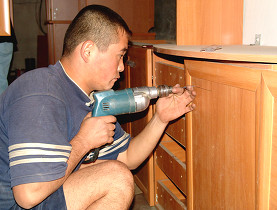Paper houses are not just for the poor

A Swiss company has come up with the novel idea of producing paper houses to give people in developing countries a roof over their heads.
The SFr6,000 ($5,500) house is the brainchild of German entrepreneur Gerd Niemöller, who has a vision of providing whole refugee camps with his invention.
“We want to create a building so that poor people in developing countries, who are without homes, can lead independent lives in a healthy living environment with a self-sufficient energy supply,” he told swissinfo.ch.
Niemöller’s 34-square-metre model house comprises a kitchen, two bedrooms, a shower and a veranda for slaughtering animals. It has been designed to provide shelter in Africa and in crisis zones.
The walls are made of panels coated with a hexagonal structure reminiscent of beehive honeycombs. Niemöller’s company, called The Wall and which has its headquarters in Schaffhausen, has patented the “Swiss Cell” construction to provide insulation and strength.
“Today airplanes and satellites are manufactured with this honeycomb technology,” said Niemöller. “These honeycombs were not affordable so we had to develop our own. We have the first high-speed produced honeycombs as mass market prices.”
Made of air
The walls, that are made of synthetic resin soaked cellulose, are incredibly stable. “Our large honeycombs can support a weight of over 200 tons per square metre,” Niemöller said.
Strictly speaking the houses are made more of air than paper. “More than 90 per cent of the house consists of air. It works because the honeycombs are so rigid,” he added.
The treatment of the material makes it resistant to fire, wind and water. Such houses can be locally manufactured within hours. “It only needs a few small trees to construct the house and needs less material than other shelters,” Niemöller said.
Mass production of the honeycomb cells will start late this year once a special machine has been developed. Measuring 1.4 metres wide, 1.6 metres high and 80 centimetres deep, the device is expected to be as small as two refrigerators, but would produce 25,000 honeycombs or 1,000 homes a month.
World Cup village
However, how will a family living in a slum in poorer countries manage to afford the SFr6,000 price tag? The Wall is working with the Catholic Church to provide micro-credits and governments could also supply funds.
In addition, the company is also colloborating with various charities such as World Vision in Switzerland. Together with this welfare organization, Niemöller plans to build a village of paper houses for the 2010 Football World Cup in South Africa.
Martin Suhr, team leader of development and cooperation at World Vision Switzerland, is enthusiastic about the idea. “This is a very innovative material that also has impressive environmental credentials,” he told swissinfo.ch.
European market
World Vision is also working with other organisations such as USAID and Habitat for Humanity. They have clubbed together with The Wall to spread the word about the paper houses worldwide.
Niemöller said that he had been overrun with enquiries. “We have more than a million houses in the pipeline. We recently received a Chinese government delegation that wants three million houses,” he said.
But Niemöller does not only want to provide houses for the developing world.
“The material would also suit housing in Europe at a reasonable cost,” Niemöller said. “It would even be possible to build a mansion or a multi-storey building with this material.”
Christian Raaflaub, swissinfo.ch (Adapted from German by Matthew Allen)
The 58-year-old Niemöller is a German national who lives in Schaffhausen in Switzerland.
His company, The Wall, is headquartered in the town, which is near the Rhine.
The machine that builds the houses is being developed in the German port city of Kiel.
The Schaffhausen headquarters will take charge of the mass production of the houses and will assemble and distribute them.

In compliance with the JTI standards
More: SWI swissinfo.ch certified by the Journalism Trust Initiative













You can find an overview of ongoing debates with our journalists here . Please join us!
If you want to start a conversation about a topic raised in this article or want to report factual errors, email us at english@swissinfo.ch.